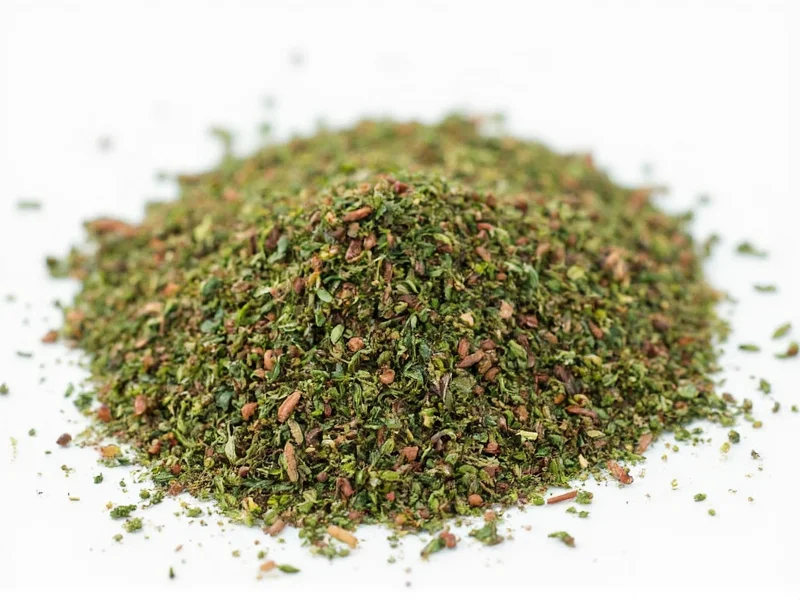Understanding the precise relationship between ground thyme and dried thyme is essential for consistent cooking results. While both forms originate from the same herb, their physical properties create significant differences in measurement and flavor intensity. Ground thyme has been pulverized into a fine powder, increasing its surface area and concentrating its essential oils, while dried thyme consists of whole or broken leaves that retain more air space between particles.
Why the 1:1.5 Conversion Ratio Matters
The 1:1.5 measurement conversion exists because ground thyme packs more herb density into the same volume. When you grind dried thyme leaves, you eliminate the air pockets between leaves, creating a more concentrated product. This concentration means ground thyme delivers approximately 50% more flavor compounds per teaspoon than dried thyme.
Chefs and home cooks often make the mistake of using equal measurements when substituting between these forms, resulting in either under-seasoned or overpoweringly herbal dishes. The conversion ratio becomes particularly crucial in delicate recipes like custards, light sauces, or subtle vegetable preparations where herb balance is critical.
Practical Substitution Guidelines
When converting between ground and dried thyme in your recipes, consider these practical guidelines:
- For every 1 teaspoon of ground thyme called for, use 1½ teaspoons of dried thyme
- For every 1 tablespoon of ground thyme, substitute 1½ tablespoons of dried thyme
- When scaling recipes up or down, maintain the same 1:1.5 ratio consistently
- Always add dried thyme earlier in cooking to allow time for rehydration
- Add ground thyme later in the cooking process to preserve its volatile oils
| Ground Thyme | Dried Thyme Equivalent | Best Used In |
|---|---|---|
| ¼ teaspoon | ⅜ teaspoon | Dressings, marinades |
| ½ teaspoon | ¾ teaspoon | Sauces, soups |
| 1 teaspoon | 1½ teaspoons | Rubbed on meats, stews |
| 1 tablespoon | 1½ tablespoons | Large batch cooking, braises |
Flavor Profile Differences
Ground thyme offers a more immediate and intense flavor release due to its increased surface area, making it ideal for quick-cooking dishes or applications where rapid flavor integration is needed. Dried thyme, with its whole leaf structure, releases flavor more gradually during cooking, which works better in long-simmering dishes like stews, braises, and stocks.
The flavor compounds in ground thyme begin degrading more quickly once exposed to air, while dried thyme maintains its potency longer. This difference affects not only substitution ratios but also storage recommendations and shelf life expectations for each form.
Storage Considerations for Maximum Freshness
Proper storage significantly impacts the potency of both ground and dried thyme, affecting your conversion accuracy over time:
- Store both forms in airtight containers away from light and heat
- Ground thyme retains peak potency for 6-12 months
- Dried thyme maintains quality for 1-2 years when properly stored
- Test freshness by rubbing a small amount between fingers and smelling
- Older herbs require slightly higher measurements to achieve the same flavor impact
When working with older herbs, you may need to adjust the standard ground thyme to dried thyme conversion ratio slightly upward. For thyme that's approaching its expiration, consider using 1 teaspoon ground thyme to 1⅔ teaspoons dried thyme to compensate for flavor degradation.
Recipe-Specific Conversion Tips
Certain dishes benefit from specific conversion approaches when substituting between ground and dried thyme:
- Meat rubs: Use ground thyme for better adhesion and immediate flavor penetration
- Soups and stews: Dried thyme works better as it releases flavor gradually during long cooking
- Baking applications: Ground thyme distributes more evenly in dry ingredients
- Vinaigrettes: Ground thyme incorporates more readily into oil-based dressings
- Vegetable dishes: Dried thyme provides visual texture that ground thyme lacks
Professional chefs often keep both forms in their pantries to leverage the unique advantages of each. Understanding the precise ground thyme to dried thyme ratio allows for seamless substitution while maintaining recipe integrity.
Common Substitution Mistakes to Avoid
Many home cooks encounter issues when substituting between thyme forms due to these common errors:
- Using equal measurements instead of adjusting for density differences
- Not accounting for the age and freshness of stored herbs
- Adding dried thyme too late in the cooking process
- Using ground thyme in applications where visual texture matters
- Storing herbs in transparent containers that degrade potency
When in doubt about thyme substitution, start with slightly less than the recommended conversion ratio, then adjust to taste. Remember that individual palates vary, and regional thyme varieties can have slightly different potency levels.
Frequently Asked Questions
Can I substitute ground thyme for dried thyme in a 1:1 ratio?
No, a 1:1 substitution will result in overly strong flavor. Use 1 teaspoon of ground thyme for every 1½ teaspoons of dried thyme to maintain proper flavor balance in your recipes.
Does the conversion ratio change for large recipe batches?
The ground thyme to dried thyme conversion ratio remains consistent regardless of batch size. Whether making a single serving or feeding a crowd, maintain the 1:1.5 ratio for accurate flavor results.
How does freshness affect the ground thyme to dried thyme conversion?
Older herbs lose potency over time. For thyme approaching its expiration date, increase the dried thyme measurement slightly (up to 1⅔ teaspoons per teaspoon of ground thyme) to compensate for flavor degradation.
Which form of thyme works better for slow cooker recipes?
Dried thyme performs better in slow cooker recipes because its whole leaf structure releases flavor gradually during extended cooking times, while ground thyme can become overly potent or bitter when subjected to prolonged heat.
Can I make my own ground thyme from dried thyme?
Yes, you can grind dried thyme leaves using a spice grinder or mortar and pestle. When making your own ground thyme, use the standard 1:1.5 conversion ratio, but note that freshly ground thyme will be more potent than commercially processed ground thyme.











 浙公网安备
33010002000092号
浙公网安备
33010002000092号 浙B2-20120091-4
浙B2-20120091-4